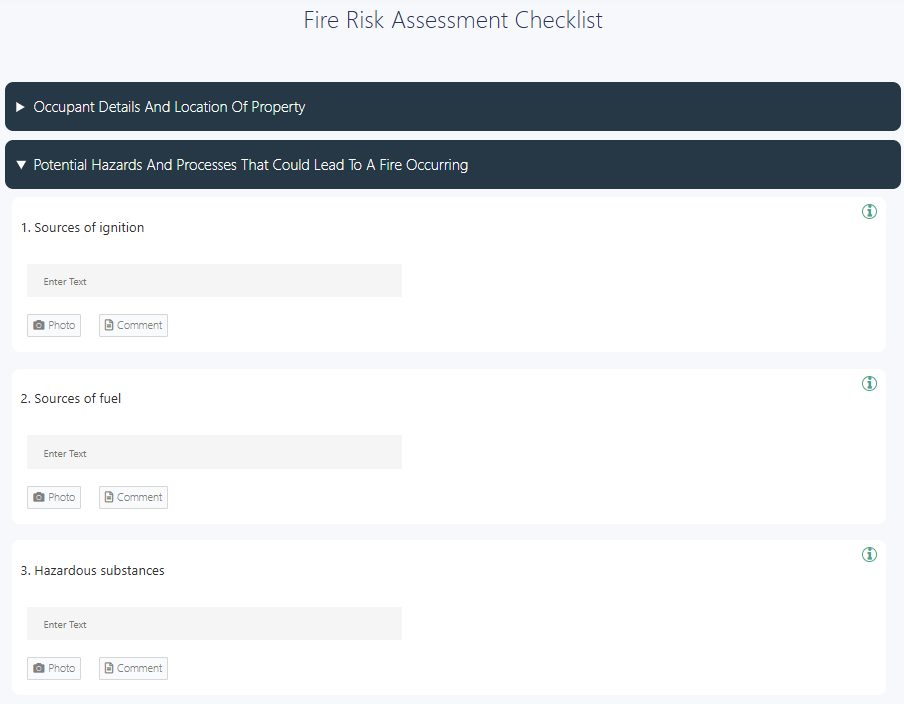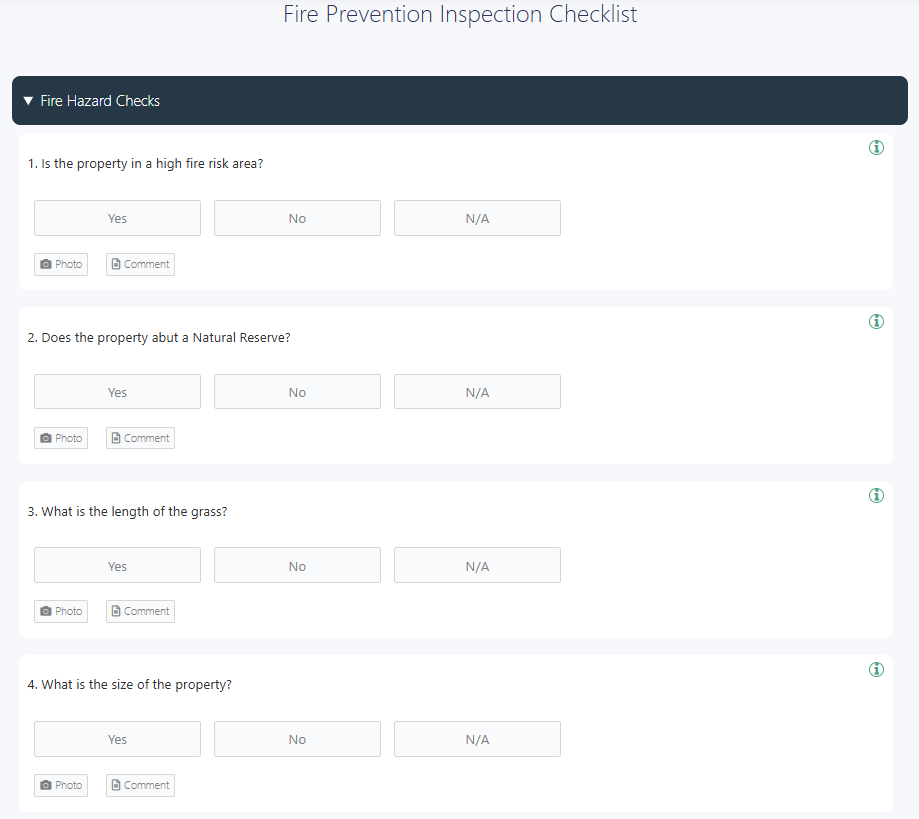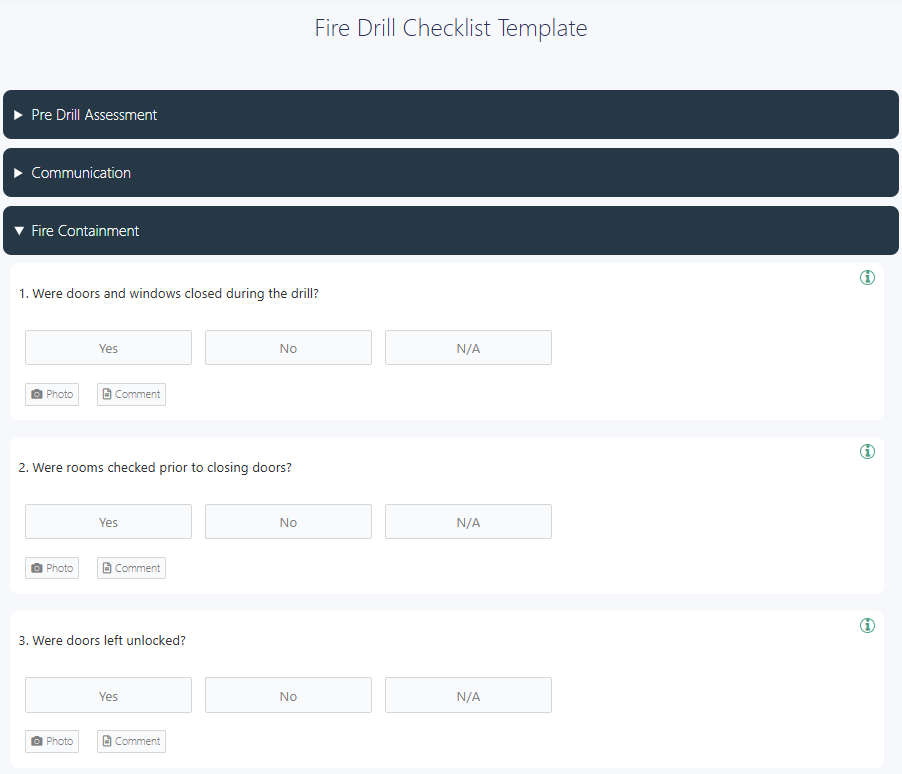Fire safety is an essential aspect of maintaining a secure and compliant workplace. Fire safety audits and inspections play a crucial role in identifying potential fire hazards, assessing the effectiveness of existing safety measures, and ensuring compliance with relevant regulations. Regular fire safety audits help organizations mitigate the risk of fire-related incidents, protect lives and property, and create a culture of safety. With a proactive approach to managing fire risks, businesses can enhance emergency preparedness, and ensure that safety protocols are up-to-date and effective. To ensure a comprehensive and effective audit, businesses can use fire safety audit checklists that cover different aspects of fire safety inspections.
In this blog, we have listed the top 10 fire inspection checklists that every business can benefit from using.
What is a Fire Inspection Checklist?
A fire safety audit checklist is a digital tool used to systematically evaluate the fire safety measures and protocols within a building or facility. It typically includes a wide range of items, such as fire alarm systems, emergency lighting, fire extinguishers, evacuation routes, fire doors, and electrical systems. Fire safety audit checklists ensure that all necessary precautions are in place to prevent fire incidents and to respond effectively in case of an emergency.
Fire safety checklists for the workplace provide a comprehensive framework for assessing compliance with fire safety regulations, identifying potential hazards, and implementing corrective actions. Organizations can significantly reduce the risk of fire-related incidents, protect lives and property, and avoid legal liabilities associated with non-compliance. Additionally, They help enhance the overall safety of the environment by ensuring that all fire safety equipment is functional, accessible, and properly maintained and that staff are well-trained in emergency response procedures.
Why are Fire Safety Audit Checklists Important?
Here are the key reasons why utilizing fire inspection checklists is important:
- Fire audit checklists guide you through a systematic evaluation of your facility, helping to uncover fire risks such as blocked exits, faulty wiring, or improperly stored flammable materials.
- Regular use of fire inspection checklists ensures adherence to local and national fire safety codes, reducing the risk of legal penalties and enhancing overall safety standards.
- Using fire inspection checklists promotes consistency across inspections, ensuring that every area is evaluated uniformly, regardless of who conducts the inspection.
- By identifying and addressing potential issues early, fire inspection checklists help prevent fire incidents, thereby protecting lives and property.
- Preventing fire incidents through regular inspections can lead to significant cost savings by avoiding property damage, operational downtime, and potential legal fees.
- Regular inspections using fire safety audit checklists reinforce a culture of safety within the organization, emphasizing the importance of fire prevention and preparedness.
- They ensure that emergency equipment is functional and that evacuation routes are clear, enhancing the facility’s readiness in case of a fire.
Top 10 Free Fire Inspection Checklists for Your Workplace
GoAudits offers the following fire inspection checklist templates as a part of its health and safety checklists. You can sign up for free and start using these fire safety audit checklists.
1) Fire Risk Assessment Checklist
The fire risk assessment form can be used by safety personnel and is designed to help you figure out if there’s a risk of fire for your employees, and take steps to prevent any potential hazards. By going through all the elements on this fire inspection form, you’ll be able to spot any fire risks and make sure everyone is safe.
👉 Use GoAudits Fire Risk Assessment Software to perform fire risk assessments effectively.
2) Monthly Fire Safety Inspection
This monthly fire inspection checklist has been designed to ensure that all precautions have been taken to avoid fire accidents. However, ensuring safety precautions are taken so that the facility is ready to act immediately in case of any fires breaking out.
3) Workplace Hazard Assessment Checklist
You can use this workplace fire safety and hazard checklist to audit and evaluate workplace hazards and develop appropriate control measures to reduce the risks associated with each hazard. Inspection topics include storage, electrical safety, room heaters/air conditioning, fire safety, first aid, and many other hazardous elements.
4) Fire Extinguisher Inspection Form
This fire extinguisher inspection form includes sections for both equipment audits and maintenance of existing extinguishers. It should be completed at least once a year by a qualified fire safety professional familiar with the specific types of extinguishers used in your workplace. The GoAudits fire extinguisher app also offers an annual extinguisher inspection form, which can be used to assess each extinguisher’s operating condition, placement, type, and quantity. Once the fire extinguisher inspection is completed, the inspector should sign the form and ensure it’s filed properly for future reference and regulatory compliance.
5) Fire Door Inspection Checklist
This fire inspection checklist offers a structured approach to ensuring fire doors meet safety and compliance standards. It includes critical components such as hinges, closers, seals, gaps, glazing, locks, and general door integrity. This checklist also ensures the presence of clear fire door signage and intact intumescent seals, which are essential for preventing smoke and fire spread. Additionally, it checks that glazing is undamaged and appropriately marked, and that locks operate smoothly and bear the necessary CE certification.
👉 Try GoAudits fire door inspection software to perform regular fire door inspections.
6) Fire Prevention Inspection Checklist
Regular fire hazard inspections can help identify issues that can lead to fires. Potential hazards can be quickly addressed to reduce the risk of potential disasters. That’s why this fire hazard inspection checklist is used by inspectors to assess the fire risk and to ensure that the proper precautions are taken in the event of a fire.
7) Fire Alarm Inspection
Regular fire alarm inspections are an essential part of any safety plan. This fire alarm inspection checklist template can be used for weekly or monthly fire alarm inspections. However, fire alarm checks should be conducted at least once a month to ensure proper system functioning, and you can use GoAudits fire alarm inspection software to do so.
8) Fire Safety Inspection Checklist
Use this fire safety inspection checklist template to check the buildings and facilities for fire safety compliance. Checklists for fire prevention, containment, and audits of escape routes are included in the form, along with checklists for procedures, training, and information.
9) Chemical Risk Assessment Template
The chemical risk assessment form is an important tool to identify chemical hazards and appropriate control measures, as part of workplace health & safety inspections aimed at decreasing risk to workers and visitors.
👉 Free Resources
GoAudits offers the following checklists to help you ensure chemical safety in the workplace. In addition to customizing these checklists to meet your requirements, you can digitize your own chemical SOPs into actionable checklists.
→ Chemical Safety Checklist – COSHH
→ HSE COSHH Assessment Template
→ MSDS Checklist – COSHH
→ HSE COSHH Assessment Template
→ Hazardous Material Inspection Checklist
10) Life Safety Code Checklist
The comprehensive fire and life safety code checklist can help you maintain fire safety standards on your building premises by auditing compliance with international safety codes. The inspection includes:
- Chemical safety
- Storage & hazardous materials
- Exiting & egress areas
- Sprinkler systems, elevator machine rooms
- Portable fire extinguishers, etc.
To download the free fire safety checklist PDF, simply click on the provided link. Each checklist can be tailored to your workplace and contains a comprehensive list of questions to help you spot potential fire hazards.
These fire safety assessment checklists even allow you to attach comments and pictures. Moreover, with the GoAudits safety inspection app & software, you can assign actions in real-time while conducting your inspection.
If you didn’t find what you’re looking for in our top 10 fire safety audit checklists, here are a few more you might find helpful:
- Hotel Fire Safety Audit Checklist
- Fire Prevention Inspection Checklist
- NFPA 25 Fire Pump Inspection
- Workplace Fire Safety Checklist
- Fire Testing Checklist
- OSHA Fire Protection Checklist
- Fire Protection System Maintenance Checklist
Remember, to keep the workplace safe, you’ll need a comprehensive fire prevention plan and regularly conduct fire inspections to mitigate potential risks. This plan should be reviewed and updated regularly. Taking these steps will help keep the workplace secure and productive, but also safeguard your business from potential harm and significant revenue losses.
Perform Fire Safety Audits & Inspections Faster with GoAudits
GoAudits is a comprehensive platform designed to streamline the process of workplace inspections, fire safety audits, reporting, and compliance with fire safety standards. Here’s how you can use GoAudits fire inspection software:

- Access ready-to-use fire safety audit checklists aligned with industry standards or customize them to meet site-specific regulations. Use the drag-and-drop interface to build your own templates, or convert your fire SOPs into digital checklists.
- Conduct fire safety inspections anytime, anywhere, even without internet access. Attach annotated photos for visual context. E-signatures, timestamps, and GPS data ensure full transparency.
- Fire safety reports are auto-generated the moment an inspection is completed. Each report includes attached images, assigned corrective actions, geolocation data, and more. Customize the report format and share it with relevant stakeholders.
- Assign corrective actions during audits and inspections with priorities and due dates. Track completion through a centralized dashboard. Get notified of overdue tasks and escalate them based on organizational rules.
- Automates task assignment, report distribution, and approval workflows. Define your organizational hierarchy within the system to ensure the right people are involved at the right time. Set automated reminders and escalation rules.
- Analyze historical data to detect trends, recurring issues, and performance gaps across fire safety processes. Compare audit scores over time, drill down to individual inspection results, track the status of all pending and completed actions, and more.
What Should a Fire Inspection Checklist Include?
Below is a detailed overview of what a fire safety audit checklist should include:
- Fire Detection and Alarm System
A reliable fire detection and alarm system is the cornerstone of any fire safety strategy. This includes smoke detectors, heat detectors, and manual pull stations strategically placed throughout the facility. Regular testing and maintenance using fire inspection checklists are essential to ensure these systems function correctly. It’s also important to verify that the alarm system is audible and visible in all necessary areas and that it is linked to the local fire department if required by regulations.
- Fire Extinguishers
A fire extinguisher inspection checklist should ensure that the correct types of extinguishers are available based on the specific hazards in the area, such as Class A, B, C, or D extinguishers. Regular inspections should confirm that extinguishers are easily accessible, properly mounted, fully charged, and within their service date. The location of extinguishers should comply with local fire codes, typically within 75 feet of any point within the facility.
- Fire Doors
Fire doors are designed to contain fire and smoke, preventing them from spreading. These doors must be inspected to ensure they are in good working condition, close automatically, and latch properly. A workplace fire safety checklist should verify that fire doors are not obstructed or propped open, as this could compromise their effectiveness during an emergency.
- Fire Exit Routes
Clear and accessible fire exit routes are essential for safe evacuation. A fire inspection form should include checks for unobstructed pathways, well-lit exit signs, and unlocked doors during occupancy. Exit doors should also be equipped with panic hardware for easy egress.
- Storage of Flammable Materials
Proper storage of flammable materials is crucial in minimizing fire risks. A fire audit checklist should ensure that all flammable substances are stored in designated, well-ventilated areas away from ignition sources. Additionally, compliance with local regulations on the quantity and type of flammable materials stored should be verified, and appropriate safety cabinets should be used.
👉 Free Resources
- Electrical Safety
Electrical fires are a common hazard in many facilities. A fire inspection checklist should include regular inspections of electrical panels, wiring, and equipment to identify potential risks such as frayed wires, overloaded circuits, or improper use of extension cords. Ensuring that all electrical systems are up to code and that proper labeling and accessibility are maintained is essential.
👉 Free Resources
GoAudits offers the following checklists to help you perform electrical audits and ensure safety. You can sign up for free and start using these checklists for free, or you can even digitize your own electrical safety SOPs into actionable checklists.
→ Electrical Safety Inspection Checklist
→ Electrical Safety Checks
→ Free Electrical Inspection Forms
→ OSHA Electrical Safety Inspection Checklist
→ Electrical Panel Maintenance Checklist
- Fire Sprinklers
Fire sprinklers suppress fires before they can cause significant damage. A fire safety checklist template should confirm that sprinklers are installed in all necessary areas, have adequate clearance, and are regularly inspected and maintained. It’s also important to check for any signs of corrosion, leakage, or physical damage that could impair their functionality.
- Fire Drills
Regular fire drills are essential for preparing occupants for an emergency. A fire inspection checklist template should include a schedule for conducting drills, ensuring that all employees are familiar with evacuation routes and procedures. Post-drill evaluations should be conducted to identify any areas for improvement.
- Fire Safety Equipment
In addition to fire extinguishers and sprinklers, other fire safety equipment such as fire blankets, hose reels, and emergency lighting should be inspected regularly. This fire safety audit checklist should verify that all equipment is in working order, easily accessible, and compliant with safety standards. This also includes ensuring that backup power sources for emergency lighting and alarms are functional.
👉 Use this free Fire Protection Equipment Checklist to ensure your fire safety equipment is in good working condition.
FAQs
Fire risks vary depending on the environment, but some are particularly prevalent across various settings.
– Electrical faults are one of the most common fire hazards, often caused by faulty wiring, overloaded circuits, or malfunctioning appliances.
– Improper storage of flammable materials is another frequent risk.
– Additionally, heating equipment, such as space heaters and furnaces, can be dangerous if not regularly maintained or if placed too close to flammable materials.
– Finally, smoking indoors or careless disposal of cigarette butts can easily start fires, particularly if smoking areas are not well-managed.
Here are the safety tips to ensure workplace and employee safety.
– Install smoke alarms
– Create an evacuation plan
– Keep fire extinguishers handy
– Maintain electrical systems
– Properly store and handle flammable materials
– Designate smoking areas
– Educate and train employees
– Keep fire exits clear
– Conduct regular fire drills
– Perform fire risk assessments
Here are the five elements of fire safety.
– Fire prevention
– Detection and warning systems
– Emergency response planning
– Fire suppression
– Regular maintenance and training







